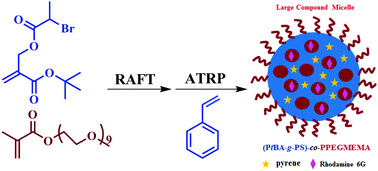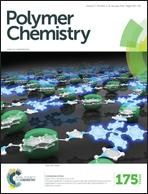(PAA-g-PS)-co-PPEGMEMA asymmetric polymer brushes: synthesis, self-assembly, and encapsulating capacity for both hydrophobic and hydrophilic agents†
Abstract
A series of well-defined amphiphilic asymmetric polymer brushes containing hetero side chains, hydrophobic polystyrene (PS) and hydrophilic poly(ethylene glycol) (PEG), was synthesized by sequential reversible addition–fragmentation chain transfer (RAFT) polymerization and atom transfer radical polymerization (ATRP). The well-defined polyacrylate-based backbones (Mw/Mn ≤ 1.22), PtBBPMA-co-PPEGMEMA, were first prepared by RAFT copolymerization of tert-butyl 2-((2-bromopropanoyloxy)methyl)acrylate (tBBPMA), which bears a Br-containing ATRP initiating group and a poly(ethylene glycol) methyl ether methacrylate (PEGMEMA) macromonomer. The reactivity ratios determined by Fineman–Ross and Kelen–Tudos methods showed that both monomers tended to form random copolymers. The density of the Br-containing ATRP initiating group could be well tuned by the feeding ratio of comonomers. ATRP of styrene was directly initiated by PtBBPMA-co-PPEGMEMA without polymeric functionality transformation to afford well-defined (PtBA-g-PS)-co-PPEGMEMA polymer brushes (Mw/Mn ≤ 1.26) via the grafting-from strategy. The pendant tert-butoxycarbonyls in the backbone were selectively hydrolyzed to carboxyls for providing (PAA-g-PS)-co-PPEGMEMA polymer brushes. Both polymer brushes with the exact same side chains, but different backbones, self-assembled into large compound micelles and bowl-shaped micelles in aqueous media, respectively. This is a direct and strong example to address the importance of the properties of the backbone of a graft copolymer on its self-assembly behavior. Interestingly, different from common spherical micelles, which can just solubilize hydrophobic compounds within their core, the large compound micelles formed by (PtBA-g-PS)-co-PPEGMEMA polymer brushes can encapsulate hydrophilic Rhodamine 6G and hydrophobic pyrene separately or simultaneously.


 Please wait while we load your content...
Please wait while we load your content...